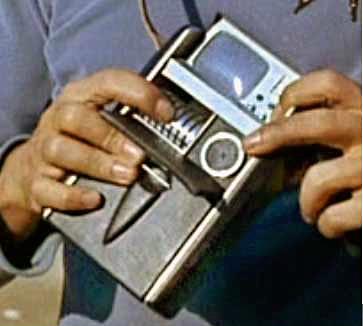Science Fiction
Dictionary
A B C D E F G H I J K L M N O P Q R S T U V W X Y Z
SCiO Scanner Wants You To Be Spock

The SCiO device contains a tiny spectrometer which, in concert with your iPhone and the SCiO cloud, can determine the composition of materials. Or so they claim.
(SCiO handheld device)
SCiO is based on the proven near-IR spectroscopy method. The physical basis for this material analysis method is that each type of molecule vibrates in its own unique way, and these vibrations interact with light to create a unique optical signature.SCiO includes a light source that illuminates the sample and an optical sensor called a spectrometer that collects the light reflected from the sample. The spectrometer breaks down the light to its spectrum, which includes all the information required to detect the result of this interaction between the illuminated light and the molecules in the sample.
Spectrometers used for near-IR spectroscopy are normally found in scientific laboratories and are very big and expensive. Designed for consumers, SCiO leverages a tiny spectrometer, designed from the ground up to be mass-produced at low cost. Consumer Physics achieved this advancement by reinventing the spectrometer around low-cost optics and advanced signal processing algorithms.
To deliver relevant information in real time, SCiO communicates the spectrum of the sample to a smartphone wirelessly, which in turn forwards it to a cloud-based service for review. Advanced algorithms utilize an updatable database to analyze the spectrum within milliseconds and deliver information about the analyzed sample back to the user's smartphone in real time.
Many of us remember the tricorder from the original Star Trek series of the mid-1960's. The standard Starfleet tricorder was used for determining various characteristics of landing areas (like life form readings). (Doctors and engineers had their own specific types of tricorder.)
The SCiO device has the additional requirement that people interact with their cloud to help them make their cloud smarter. It kind of reminds me of Ava, an AI from a pretty cool novel The Calcutta Chromosome published in 1995. Ava used people to answer questions endlessly about every last piece of junk it encountered. The SCiO cloud might be a bit like that. That's why I think it wants you to be Spock; you roam around and whenever it doesn't know something, it will want you to provide more data.
Apparently, you can pre-order one of these little beauties now.

(Spock's Tricorder - Detail)
For other news related to sensors and science fiction, see EyeBall: Omni-Directional Smart Eye Sensor and ThereminVision Sensor: Robot Proximity Detection.
Scroll down for more stories in the same category. (Story submitted 1/27/2016)
Follow this kind of news @Technovelgy.| Email | RSS | Blog It | Stumble | del.icio.us | Digg | Reddit |
Would
you like to contribute a story tip?
It's easy:
Get the URL of the story, and the related sf author, and add
it here.
Comment/Join discussion ( 0 )
Related News Stories - (" Engineering ")
Replace The Smartphone With A Connected Edge Node For AI Inference
'Buy a Little Dingbat... electropen, wrist watch, pocketphone, pocket radio, billfold ... all in one.' - Raymond F. Jones, 1945.
Sunday Robotics 'Memo' Bot Has Unique Training Glove
'He then started hand movements of definite pattern...' - Robert Heinlein, 1942
Tornyol Microdrone Kills Mosquitoes
'The real border was defended by... a swarm of quasi-independent aerostats.'
PLATO Spacecraft, Hunter Of Habitable Planets, Now Ready
'I ... set my automatic astronomical instruments to searching for a habitable planet.' Edmond Hamilton (1936).
Technovelgy (that's tech-novel-gee!) is devoted to the creative science inventions and ideas of sf authors. Look for the Invention Category that interests you, the Glossary, the Invention Timeline, or see what's New.
Science Fiction
Timeline
1600-1899
1900-1939
1940's 1950's
1960's 1970's
1980's 1990's
2000's 2010's
Current News
Replace The Smartphone With A Connected Edge Node For AI Inference
'Buy a Little Dingbat... electropen, wrist watch, pocketphone, pocket radio, billfold ... all in one.'
Artificial Skin For Robots Is Coming Right Along
'... an elastic, tinted material that had all the feel and appearance of human flesh and epidermis.'
Robot Guard Dog On Duty
I might also be thinking of K-9 from Doctor Who.
Wearable Artificial Fabric Muscles
'It is remarkable that the long leverages of their machines are in most cases actuated by a sort of sham musculature...'
BrainBridge Concept Transplant Of Human Head Proposed
'Briquet’s head seemed to think that to find and attach a new body to her head was as easy as to fit and sew a new dress.'
Google's Nano Banana Pro Presents Handwritten Math Solutions
'...copy was turned out in a charming and entirely feminine handwriting.'
Edible Meat-Like Fungus Like Barbara Hambly's Slunch?
'It was almost unheard of for slunch to spread that fast...'
Sunday Robotics 'Memo' Bot Has Unique Training Glove
'He then started hand movements of definite pattern...'
Woman Marries Computer, Vonnegut's Dream Comes True
'Men are made of protoplasm... Lasts forever.'
Natural Gait With Prosthetic Connected To Nervous System
'The leg was to function, in a way, as a servo-mechanism operated by Larry’s brain...'
Spidery 'Walk Me' Toyota Autonomous Wheel Chair Like Star Wars
Walk along with the emperor.
Dancing Robots Taught Dance Moves
'A clockwork figure would be the thing for you...'
Proof Of Robothood - Not A Person
'Who are you people? - Show 'em.'
Indonesian Clans Battle
'The observation vehicle was of that peculiar variety used in conveying a large number of people across rough terrain.'
The 'Last Mile' In China Crowded With Delivery Robots
Yes, it's a delivery robot. On wheels.
Tornyol Microdrone Kills Mosquitoes
'The real border was defended by... a swarm of quasi-independent aerostats.'
